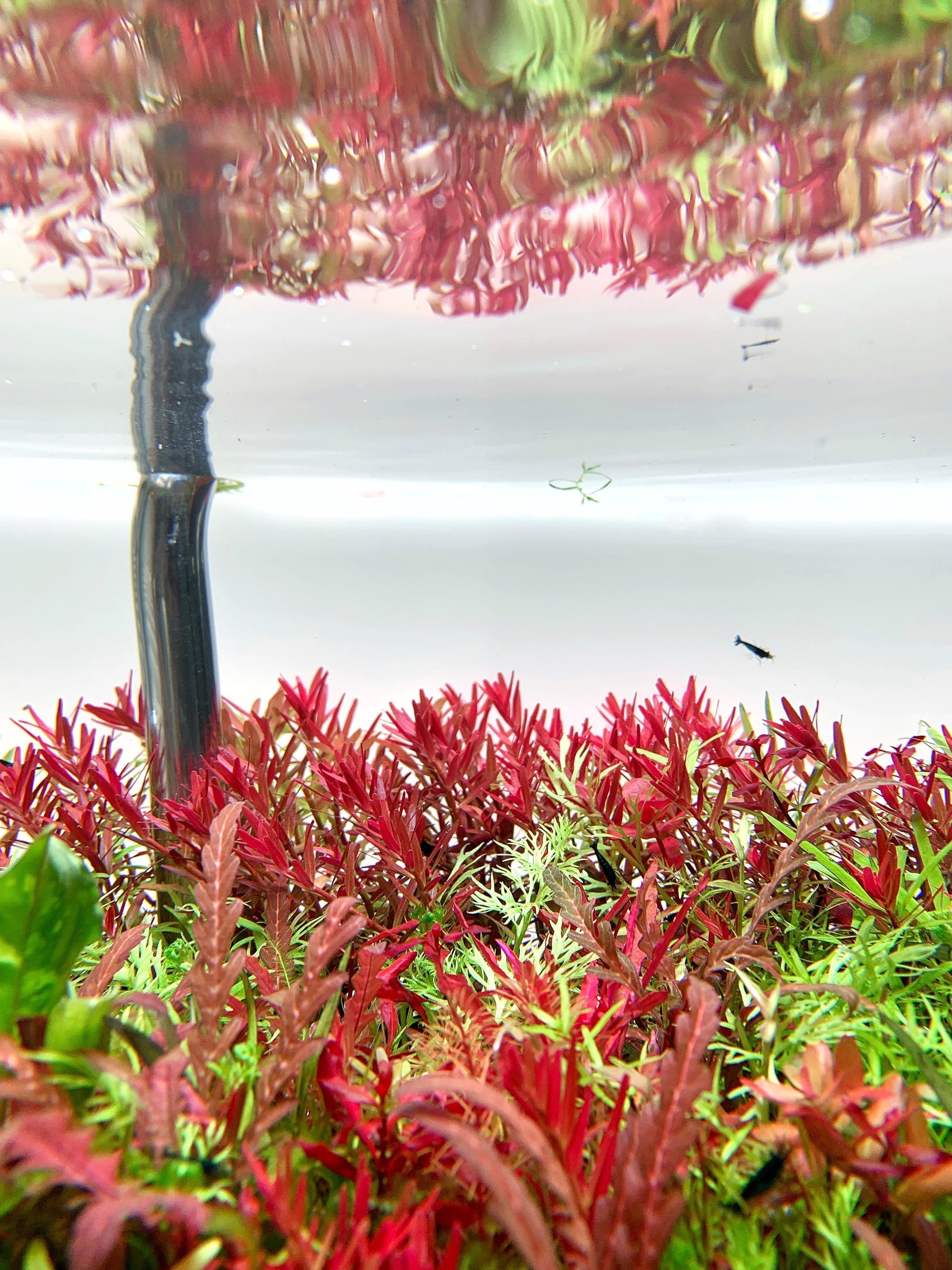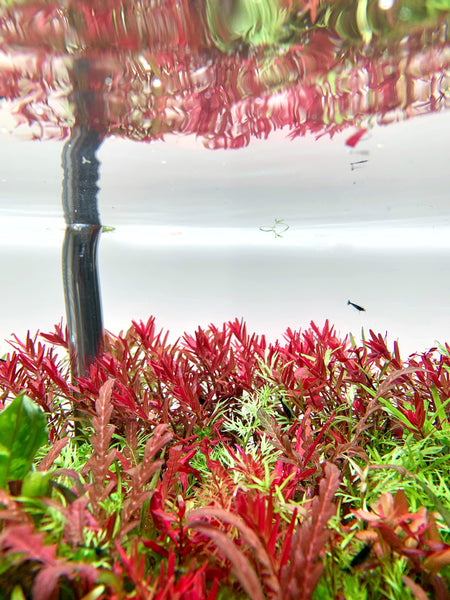
Understanding Water Parameters in your Planted Tank
By Chris A.
Out of all the ingredients that go into a successful planted tank- lighting, filtration, substrate, fertilization hardscape among them - I would argue that the quality of the water used in the tank may be most important. Just like we couldn’t survive breathing toxic air, plants and livestock will have a difficult time thriving in subpar water. The way people talk about water parameters can be confusing, but an understanding of what makes “good water” in a planted tank is critical for maintaining a healthy aquascape. Here is my simple breakdown of what all mumbo jumbo actually means.
The main parameters that aquarists monitor are pH, GH, KH, and TDS, and each is super important!
The pH is a measure of how acidic the water is, with a lower pH being more acidic; any pH within a range of 6.5-7.5 will be OK for most fish and plants. This measure is obtained by quantifying the number of hydrogen ions (H+) present in a given volume of water. The more H+, the more acidic the water.
The KH is a measure of how well the water will resist swings in pH through the presence of a dissolved buffering element (carbonate). An oversimplification of the way this works is that the negatively charged carbonate wants to bind to the positively charged hydrogen ions (H+), resulting in a neutral charge and thus a net effect of stabilizing the pH through the reduction of free H+ ions. A high KH has no direct effect on fish health at normal levels, but some shrimp and plants that prefer acidic conditions do not like high KH levels, which can raise the pH. These pH swings are primarily a problem if there is a low KH and CO2 is being intermittently injected into the water; CO2 tends to temporarily make the water more acidic, and when the CO2 is turned off for the evening, the pH can swing wildly up to a higher level, stressing out the tank’s inhabitants. A KH value lower than 4.5 dH necessitates monitoring the pH for swings; if swings aren’t happening, I would not worry too much about it being low.
GH is a measure of dissolved magnesium and calcium ions, and this is what people generally mean when they talk about “soft” or “hard” water. In general, plants and most tropical fish/shrimp do best in a range of 4-8 dH (dH stands for ‘degree hardness’), which would be considered somewhat soft. Anecdotally, I have also noticed that if KH and GH get too high, certain filamentous algae varieties tend to thrive at a higher rate than normal.
Finally, the TDS (total dissolved solids) is a measure of other dissolved substances in the water; an especially high value can be a sign of poor water quality.
In my tanks, the pH is generally 6.8-7, the GH is 4-6 dH, the KH is relatively low (my pH stays at a relatively stable value due to the presence of an acidic substrate and driftwood) the TDS is around 90-100 ppm (parts per million).
At the most fundamental level, it’s important for water to be free of chlorine and other contaminants. Occasionally people will DM me on my Instagram account describing a scenario where fish and shrimp always seem stressed (or even die) after water changes. Very frequently, this is caused by tap water that is not fully conditioned for use in an aquarium. Simply leaving the water out in a bucket overnight (the idea is that chlorine in the tap water will evaporate) is not sufficient to remove all potentially toxic contaminants, most notably chloramine (increasingly used by municipal water departments) or dissolved heavy metals. It is for this reason that I use remineralized RODI (RODI stands for reverse-osmosis deionization) water, which I will explain in greater detail shortly. If tap water is used, it’s essential to use some sort of conditioning product.

Beyond these potentially harmful substances, there are often other substances present in tap water that can result in suboptimal conditions for plant growth and livestock. Dissolved silicates can encourage the growth of diatomaceous algae; dissolved phosphates, often present in abundance in tap water, can contribute to algae growth in general. Again, trace metals such as copper can be extremely dangerous for shrimp. Dissolved cations present in tap water can increase water hardness. Unfortunately, water priming products are often not able to remove all of these substances (another reason to use RO water if necessary).
In general, it is best to test your local tap water before adding it to your tank. Another option is to obtain the water chemistry values from your municipality’s water department. Either way, if your water is close to ideal right out of the faucet (minus chlorine/chloramine), there is no need for using RODI water. But if your water comes out of the faucet with a high pH and high KH/GH, it is certainly worth using RODI water, which is essentially pure water that is created by forcing tap water through various semipermeable membranes. A good RODI filter that can screw directly onto most faucet heads will only set you back around $100 USD or less.
If you do use RODI water as I do, make sure to remineralize it before adding it to your tank; otherwise it will be harmful to your livestock and plants (a gradient can form where pure water will seek to equalize osmolarity with the water contained in living cells, which have a higher amount of dissolved substances- ultimately resulting in the cells swelling and potentially rupturing). I remineralize my RODI water using Salty Shrimp GH+, but for most beginners, I would recommend a product that also ads to the KH (such as Salty Shrimp GH/KH +).
Finally, even if your water is ‘perfect’ when added to the tank, it certainly will not stay that way for long. With an open-topped tank, water molecules will evaporate, leaving behind all of the dissolved cations and wastes; if more tap water is added on top of this, the concentration of these dissolved elements will gradually increase, to the (admittedly very slow) detriment of your plant and fish health. Worse, organic waste from the breakdown of plant tissue and livestock excrement will accumulate in the water. That’s why it’s ideal to do large, frequent water changes (I do 20-30 percent, three times per week), and to ‘top off’ any evaporated water with pure RODI water prior to water changes (if the tank has an open top).
I really hope that this quick guide has given you some understanding of why water conditions are so important for healthy planted tanks, and how you can ensure that yours are ideal for your setup. The moral of the story: most plants and tropical fish prefer slightly soft, somewhat acidic-to-neutral water, and if your tap water does not fit this description, it may be time to invest in a RODI filter or obtain RODI water from another source.
Tell us - Was this article helpful? Please leave a comment below!
If you have any questions regarding this article, please DM us on Instagram, Facebook, or email support@buceplant.com so we can assist you - @buceplant







Comments
Leave a comment